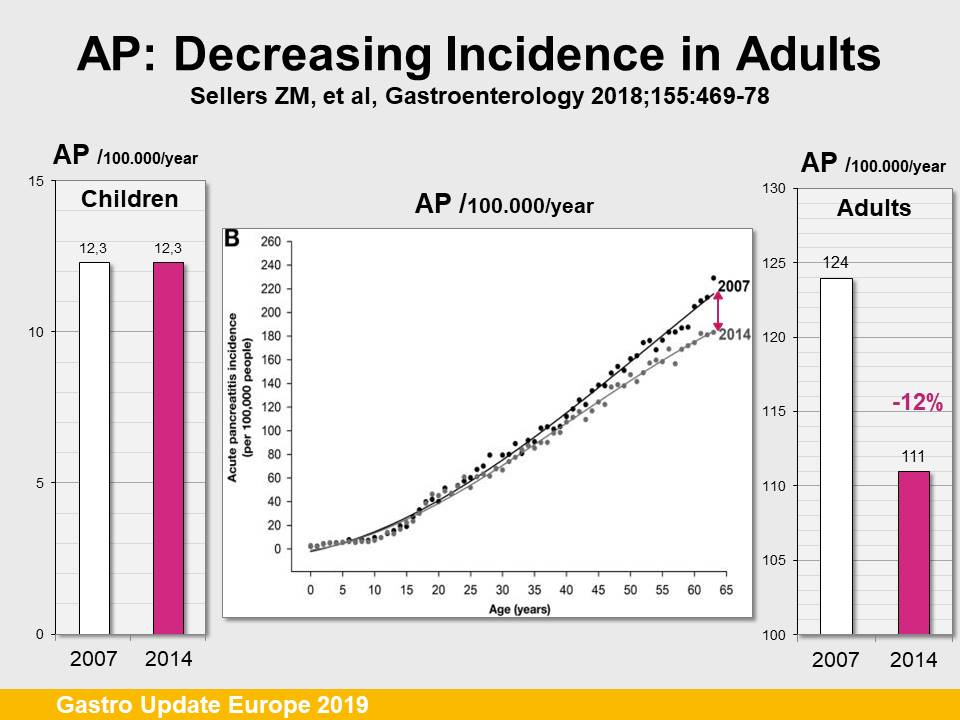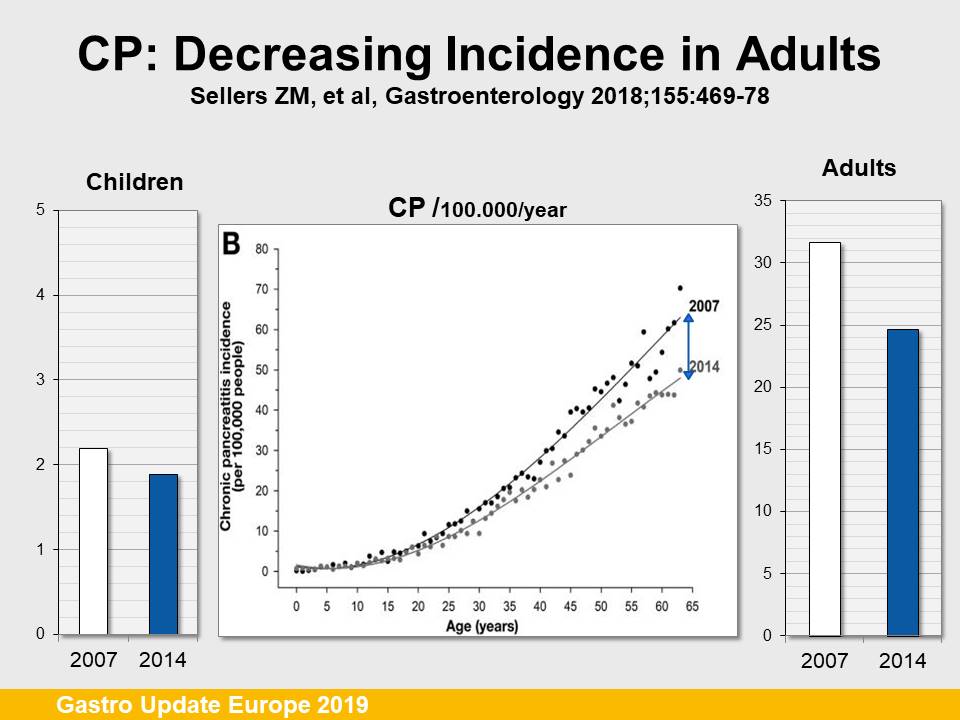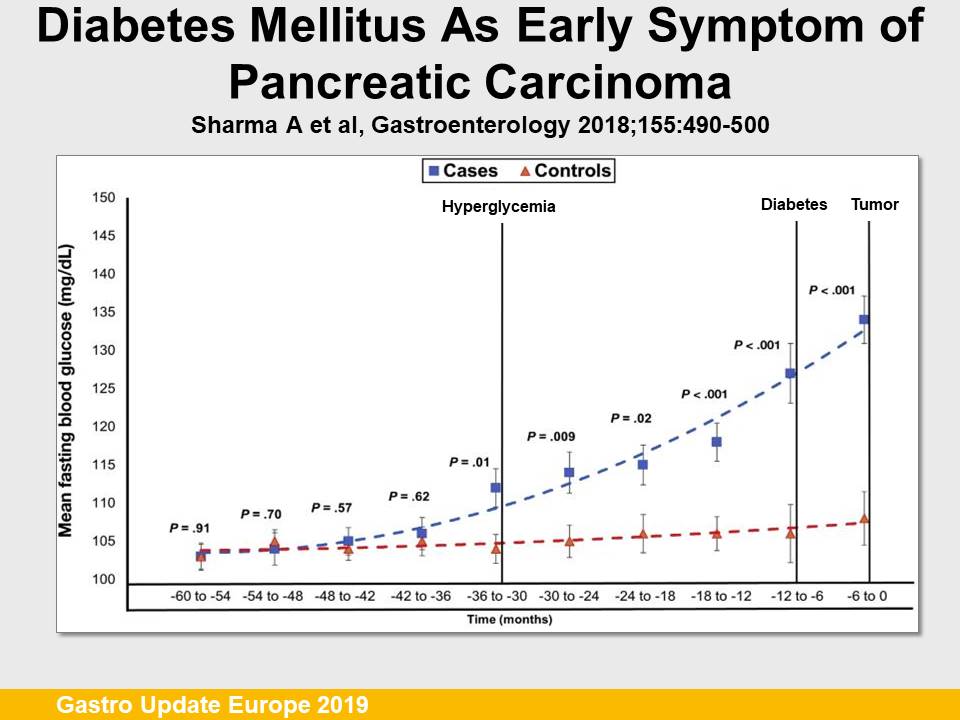Novel Pancreatic Developments prof. Peter Layer – Gastro Update Europe 2019, Budapest
Guido Tytgat1
+ Affiliation
The steadily rising incidence over the previous decades of acute and chronic pancreatitis, presumably related to alcohol and tabacco consumption, obesity and cholelithiasis, was recently shown in a large American insurance data base to decline in adults, but not in children (Fig. 1 and 2 – available only on the web site www.cshg.info). If this decline is related to decreasing nicotine consumption or increasing endoscopic/surgical obesity treatment remains speculative.
Eluxadoline, a mixed opioid receptor modulator, available in some European countries for diarrhea-predominant irritable bowel syndrome, was shown in a post-marketing surveillance, to be responsible for inducing acute pancreatitis in over 16% of the adverse events compared to less than 1% for all other anti-diarrheas (related to sphicter of Oddi dysfunction). This would demand a re-evaluation of eluxadoline’s benefit-hazard ratio (HR).
Ramadan, celebrated by Muslims, includes dawn-to-dusk fasting, followed by an opulent evening meal which may lead to massive gall bladder contractions, perhaps favoring gall stone mobilization with risk of pancreatitis. Indeed, the risk of acute pancreatitis was shown to be 2.5× higher during the Ramadan month. Following prolonged fasting, massive nutritive stimulation may lead to vigorous contraction of a distended gall bladder, to rapid increase in serum triglycerides and glucose and to massive stimulation of pancreatic enzyme secretion. Ramadan followers should be advised to break the fast gradually, especially if cholelithiasis is present.
A simple cheap and particularly rapid prognostic marker in acute pancreatitis is the neutrophil-to-lymphocyte ratio in peripheral blood. The normal ratio is approx. 1.65. A value > 10 was shown to predict high severity of acute hypertriglyceridemia-induced pancreatitis, with prolonged hospital stay, enhanced risk for Systemic inflammatory response syndrome and renal failure. These exciting data warrant further prospective evaluation in all forms of acute pancreatitis.
Acute pancreatitis is often associated with nausea, vomiting, gastrointestinal hypomotility and subileus, conditions favoring bacterial overgrowth, bacterial translocation and infectious complications. Bacterial overgrowth, studied by a (poorly sensitive) glucose breath test at day (d) 7 in over 200 pancreatitis patients, was demonstrable in over 25% of the patients with a severe cause and with organ complications. Early enteral feeding, whenever feasable, would presumably lead to early stimulation of gastrointestinal motility and reduction of intestinal stagnation and bacterial overgrowth.
Healing of acute pancreatitis may be associated with irreversible structural and functional deficits. The prevalence of exocrine pancreatic insufficiency was evaluated some 36 months (m) after the acute attack in a meta-analysis involving almost 1,500 patients. Exocrine insufficiency was present in one quarter of the patients, particularly in patients with alcoholic pancreatitis or with a severe necrotizing course. Clinicians should be on the outlook for insufficiency during follow-up. Unfortunately, an easy simple (stool) test, also sensitive for minor degrees of insufficiency, is still not available.
Over the last few years, a paradigm shift has occurred with respect to the management of acute necrotising pancreatitis. Early emergency surgery (often open necrosectomy) is obsolete and initial management should be conservative. If surgical intervention should be necessary it should be selective, late elective and leading to minimal trauma. Minimally invasive surgery led to a 20–30% lower mortality compared to open necrosectomy. Also, endotherapy in high risk patients had a 60–79% lower mortality compared to open necrosectomy. Optimal management of severe acute pancreatitis with infected necrosis requires an individually adapted minimally invasive strategy. If interventions are needed, endoscopic methods are less traumatic and produce overall better results compared with minimally invasive surgery. This was again confirmed in a recent study, showing that endoscopic therapy when performed in experienced centers by experts is safe and cost-effective. The main reasons for endoscopic superiority was a lesser occurrence of enteral or pancreatic-cutaneous fistulae and lower rate of systemic inflammatory response syndrome.
Chronic pancreatitis is a dreadful condition. Alcohol and smoking have a deleterious influence on the natural evolution as shown by an approx. 10 year (y) follow-up study comparing alcoholics (75% smokers) to non-alcoholics (< 40% smokers). Chronic pain, pseudocysts, pancreatitis flares, exocrine insufficiency, and number of hospitalisations were significantly higher in the alcoholic cohort. Stressing the need to abstain from alcohol and to stop smoking remains of high clinical relevance.
Intriguing is the impact of statins on the natural evolution of chronic pancreatitis, as shown in a population based cohort of close to 5,000 patients of whom 43% died and 2.4% developed pancreatic cancer. Overall mortality, disease progression and pancreatic cancer risk were lower in statin users. Statin use may be associated with protective (anti-fibrogenetic, anti-carcinogenetic) effects in chronic inflammatory diseases such as chronic pancreattis.
Intraductal papillary mucinous neoplasia (IPMN) may occasionally lead to cancer, particularly when involving the main pancreatic duct. Many use the Fukuoka criteria to estimate the cancer risk, looking for worrisome features (pancreatitis, cyst > 3 cm, thickened or enhanced cystic wall, main pancreatic duct > 5 mm, non-enhanced cyst mural nodule, abrupt change in main pancreatic duct caliber with distal atrophy) and high-risk stigmata (HR) (obstructive jaundice, solid components with enhancement, main pancreatic duct > 10 mm). European guidelines were recently published regarding the diagnostic and therapeutic management of IPMN (Fig. 3).
Based on several new studies following main recommendations conclusions can be drawn: IPMNs, even if initially Fukuoka negative, are (and become) never „safe“. Therefore, long-term surveillance (> 5 y) is warranted, as long as the patient is fit for surgery; initial cyst size alone is not a worrisome feature per se but predicts later development of worrisome features, as does also occur for rapidly enlarging cysts by > 2.5 mm/y.
For cysts of an indeterminate nature, measuring glucose in the cyst fluid may offer a simple, quick, cheap and precise diagnostic marker for its neoplastic nature. This was shown in a study of over 150 resected cystic lesions of various subtypes. Cyst glucose was substantially lower in the mucinous type cysts compared to non-mucinous cysts. Using a glucose cut-off value of 50 mg/dl, the accuracy of the glucose test was 90% compared to 69% for Clinical use of carcinoembryonic antigen determination with a cut-off at 192 ng/ml.
Cyst ablation may be attempted in high risk IPMN in patients unfit for pancreatic surgery by endoscopic ultrasound-guided instillation of cytostatic drugs (gemcitabine and paclitaxel) dissolved in alcohol or saline respectively. Complete cyst ablation at 12 m was obtained in respectively 61 and 67, with severe 30 d adverse events in 6% vs. 0% and mild 30 d adverse events in 22 vs. 0%. These results need to be confirmed in other studies with long-term follow-up before this method becomes standard therapy.
Pancreatic cancer remains the number one dismal conundrum in gastroenterology. For many years, prevention has been suggested by drugs such as acetylsalicylic acid and vitamin D. Disappointingly, the large long term American nurses/health professionals study revealed that both drugs offered no relevant protection against pancreatic cancer. As biomarkers for early disease are not yet available, we are left to be on the outlook for early symptoms. Newly diagnosed diabetes may be the first symptom of an underlying pancreatic malignancy. This was nicely shown in 219 cancer cases vs. 440 controls. As shown in the fig. 4 (available only on the web site www.cshg.info), hyperglycemia may be observed as early as 30–36 m prior to cancer diagnosis. The degree of blood glucose elevation correlated with both the tumour size and degree of undifferentiation.
Development of pancreatic cancer points to complex interactions with the metabolism of glucose, with chronic hyperglycemia favoring neoplasia. Therefore, in all patients with new onset of diabetes, particularly when associated with preceding weight loss, increased vigilance is mandatory and, as a rule, abdominal ultrasound is warranted.
Department of Gastroenterology andHepatology
Academic Medical Center
Meibergdreef 9
1105 AZ Amsterdam
The Netherlands
g.n.tytgat@amc.uva.nl
To read this article in full, please register for free on this website.
Benefits for subscribers
Benefits for logged users
Literature
1. Diagnostic and therapeutic management of IPMN: European guidelines. European Study Group on Cystic Tumours of the Pancreas. Gut 2018; 67 (5): 789–804. doi: 10.1136/gutjnl-2018-316027.
The Gastro Update Europe 2020 will be held on September 4–5, 2020 in Bratislava, Slovakia. For more information visit www.gastro-update-europe.eu.


